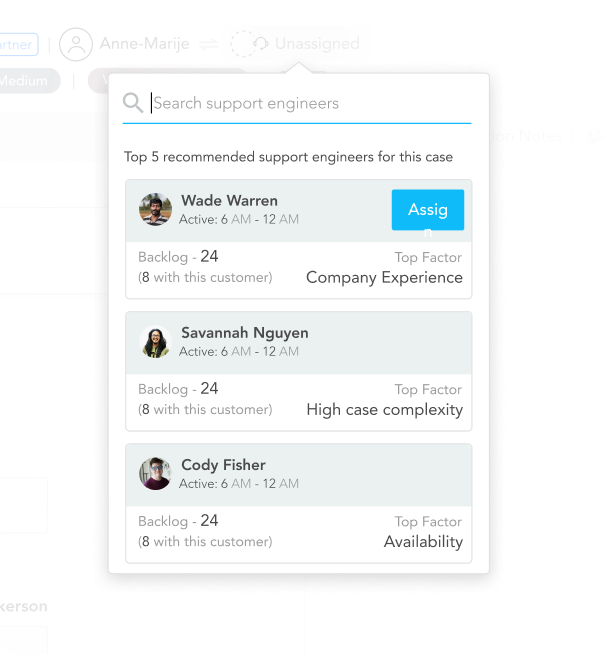
Feb 8, 2021
Your Guide to Eliminating Customer Service Burnout for Good
agent managementcustomer service burnoutcustomer service stressproactive support
Think of customer service employees as primary care providers for your business — they’re the first stop for customers looking to solve basic or complex problems. Just as a rise in critically-ill patients increases levels of burnout in doctors, distressed customers and an overflowing queue lead to customer service burnout.
While things like vacations or meditation may temporarily refresh your employees, a complex issue such as customer service burnout takes more than a three-day retreat to fix. Specifically, customer service burnout calls for a shift in the way you think about customer service — from reactive to proactive. Imagine if you could prevent adding more patients (read: hassled customers) to your customer support emergency room in the first place. That’s the goal of proactive support.

What Is Customer Service Burnout?
Seventy-four percent of contact center agents report facing customer service burnout risk, while 30% said they faced high burnout risk. HelpGuide, a nonprofit focused on mental health, defines burnout as a “state of emotional, physical, and mental exhaustion caused by excessive and prolonged stress.” Employees who experience customer service burnout may feel “overwhelmed, emotionally drained, and unable to meet constant demands.”
Interestingly, the term “burnout” was coined to describe the high levels of stress experienced by helping professions, such as doctors and nurses. Similarly, because of the nature of their job, customer service professionals are prime candidates for burnout.
Customer service burnout is a gradual process. One angry customer or five may not result in burnout. However, dealing with a constant stream of unhappy customers each day leads to stress and anxiety.
What are some early signs of customer service burnout? Detachment from work, procrastination, isolation, and loss of motivation are some symptoms to watch out for.
What Causes Customer Service Stress?
Customer service burnout and stress are often triggered by a combination of factors. Some of these may include:
- Inflexible company policies: This signals a lack of autonomy among employees, which affects their mental health and morale.
- Inefficient tools and technology: A recent study found a lack of collaboration and CRM tools to be a major challenge for contact center leaders.
- Lack of support from support managers: The absence of recognition and support from leadership is a top driver of customer service burnout.
- Lack of clarity: 72% of employees feel their managers could define clearer goals.
- Lack of a customer-focused culture: More than half the agents facing severe burnout risk (52%) also agree their company lacks a customer focused culture. On the other hand, 95% agents not facing burnout risk say their company prioritizes the customer.
Most of these factors are characteristics of a reactive customer support system.
For instance, managers conditioned to react, not act, are likely to have a problem defining clear goals. Similarly, investing in collaborative tools for support is often an afterthought in reactive support systems.
So, how can support teams pivot from reactive customer service to a proactive customer service experience?
What’s the Difference Between Reactive Customer Support and a Proactive Support Experience and Why It Matters for Your Customer Service Team
A reactive customer support system aims to solve customer problems as they arise. Agents usually run from one fire to the next, with no clear way to prioritize requests or capture customer feedback resulting in customer service burnout. On the other hand, proactive customer service experience aims to prevent customer service issues from arising as well as escalating.
Reactive Customer Support
A reactive customer support system creates many problems, including:
- A higher number of customer escalations
- High resolution times, as agents struggle to find information
- Recurring product issues, as customer feedback is siloed
Agents in reactive customer support systems may feel like they’re running around in circles — customer requests keep piling up, product issues persist, and they’re nowhere close to improving the support experience. It’s easy to see how such a system fosters a lack of clarity and poor collaboration and promotes a non-customer-focused culture.
Proactive Customer Support
Most companies think proactive customer support is about having a knowledge base, chatbots, and self-service options, but these are just the tip of the iceberg.
In practice, proactive customer support is about preventing customer problems from reaching a boiling point and predicting customer issues before they arise.
What does that look like? Proactive customer support teams may do one or more of the following:
- Monitor and resolve customer service issues likely to escalate
- Set priorities, goals, and benchmarks to improve
- Assign the right case to the right agent for faster resolution
- Have complete context for each customer based on past interactions
- Identify and resolve recurring product issues
Together, these activities help companies deliver a superior support experience to customers, as well as support employees.
4 Ways Proactive Customer Service Prevents Customer Support Burnout
Proactive customer support helps you build a better working environment for agents. Here’s how:
1. Decreased support calls
Anticipating issues before the customer reaches out is a cornerstone of proactive customer service. This reduces your support volume and gives more breathing room to your team.
For instance, payment provider Square offers predictive support based on customer actions within the app. Let’s say a customer starts offering card payments. Square automatically sends them a guide to card swiping and card readers.
Apart from monitoring activity inside your product, another way to predict where customers may run into issues is by looking at past support interactions. These are a gold mine of feedback on your product, as well as on documentation and onboarding. Use them to identify common points of friction, and fix them to reduce incoming requests.
2. Reduced resolution times
Speedy resolutions are a result of coordination between support and other teams — marketing, finance, and product. Proactive teams recognize this and prioritize tools that boost collaboration.
As one study shows, organizations with collaborative customer service processes are able to answer queries 46.1% better on the phone and 34.3% better by email.
Investing in customer service infrastructure offers another advantage: visibility into a customer’s support interactions. This helps agents dive straight into solving a customer’s problem and save time on the usual back-and-forth.
3. Decreased escalations
Customers escalate issues for two main reasons: either they’ve waited too long for an answer, or they haven’t received a response at all.
Proactive support teams avoid escalations by keeping a close tab on all support conversations. They extract insights from support tickets such as product feedback, churn risk, customer sentiment, and the next steps the customer is likely to take. This helps them identify and prioritize issues on the brink of escalation.
Using a tool like SupportLogic’s Predictive Alerts, you can monitor support conversations in real time and get notified about high-priority issues. Data platform Qlik reduced customer escalations by 30% in six months using the tool.
4. Optimized agent workload
One of the most frustrating aspects of poor support experience is a representative who “lacks the knowledge or ability to resolve” an issue, as per one study. This is why proactive support focuses on matching the right tickets to the right agent.
Here’s how it works using SupportLogic’s Intelligent Case Assignment tool as an example:

Agents are assigned cases based on their availability, skills, and past performance.
This helps agents spend more time on issues they’re qualified to solve and not on manually routing tickets. What’s more, it prevents overloading agents with more cases than they can handle and reduces customer service stress.
Happy Agents Are Better for Business
Proactive support keeps morale high, helps your agents do their best work and prevents customer service stress — and it all directly impacts your bottom line.
As one study shows, the top reasons why customers abandon a brand are a bad employee attitude, inefficiency, and unfriendly support. On the other hand, good customer experiences drive customer loyalty.
Further, improving your agents’ working environment may also help you combat high attrition rates, absence, and low levels of adherence — major concerns for customer service leaders.
SupportLogic offers a range of tools to reduce escalations and improve workload management, such as Escalation Management, Agent Management, and Predictive Alerts. Sign up for a free trial today!
Don’t miss out
Want the latest B2B Support, AI and ML blogs delivered straight to your inbox?






